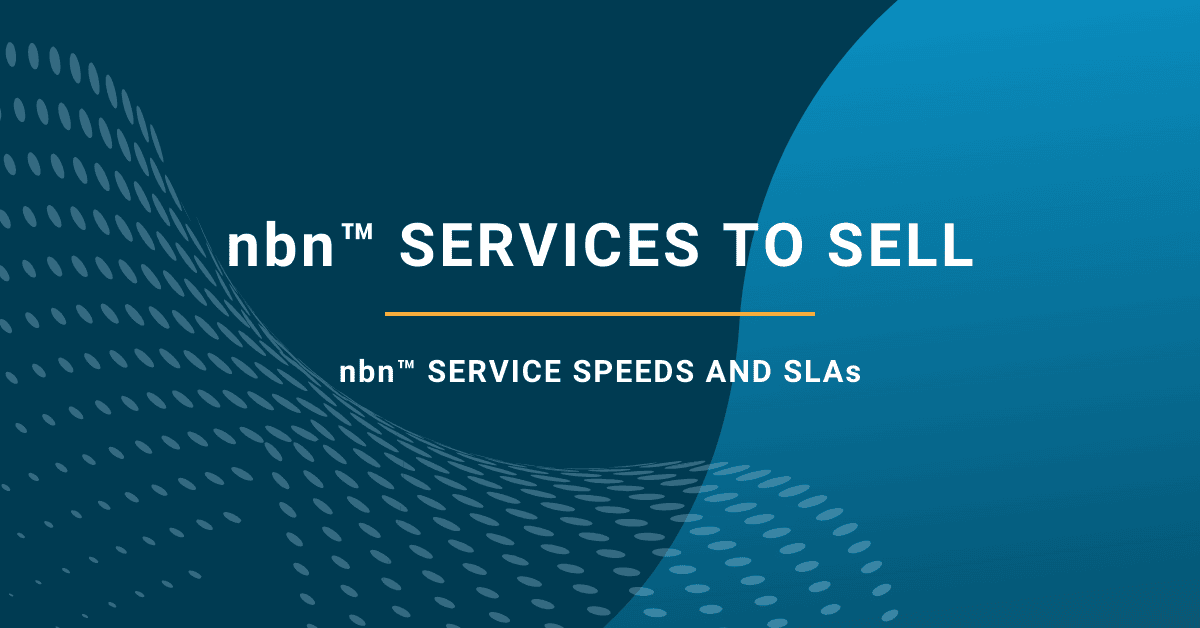In this blog post, we will get into specifics around Australia’s National Broadband Network (NBN) service speeds and SLAs you can provide to select for your clients with NBN.
NBN services are divided into two categories, “Traffic Class 4 (TC4)” and “Enterprise Ethernet”, the former is typically used for residential or small businesses, whereas the later is used for businesses that rely on internet connectivity
NBN TC4 speed options
NBN’s Traffic Class 4 (TC4) offers a range of asymmetrical speed options.
Fixed-line Connections
For FTTP, FTTB, FTTC, HFC and FTTN services, the typical speed tiers available are 12/1 Mbps (download/upload), 25/5 Mbps, 50/20 Mbps, and 100/40 Mbps.
250/25 Mbps and 1000/50 Mbps services are also available on certain FTTP and HFC connections.
Fixed Wireless
Speed tiers available are typically 12/1 Mbps, 25/5 Mbps, and 76/10 Mbps and a best-effort service for 50/20 Mbps + depending on location and network
Satellite (Sky Muster)
Speed tiers are generally lower due to the technical limitations of satellite technology. Commonly, speed tiers are up to 25/5 Mbps
NBN Enterprise Ethernet Speed Options
NBN Enterprise Ethernet (EE) tops out at a symmetrical speed of 10 Gbps. You can scale NBN EE from 10Mbps right through to that maximum upper limit of 10000Mbps, making it a much more flexible option.
Over and above speed though, you also need to consider whether High Class of Service (CoS) or Low Class of Service (CoS) will be best for your clients. We covered the differences between NBN high CoS and low CoS here, but it likely goes without saying that there is a significant difference in price between the two.
When looking at Low CoS, given it is a best effort class of service, there are a few key reasons why you would choose it over TC4, namely:
- Scalable symmetrical speed profiles allow for upload to scale well past anything on offer on NBN plans. If your client has a high volume of uploads, this is a better bet.
- Future-proofing. Given NBN EE is always delivered via FTTP (Different NBN access types are explained here), and given new service speeds and features are almost exclusively added to this access type, your clients will be ready to benefit as the product evolves.
- Superior SLA by default – more on this here.
The decision to purchase High CoS NBN EE over TC4 is obviously much more straight forward. The above points remain true, but there is also the committed traffic class which ensures end user experience and application performance. Whether the higher price point is justified by the peace of mind this brings will be a case-by-case proposition.
NBN service fault resolution
For businesses with critical data needs, NBN offers enhanced Service Level Agreements (eSLAs) that provide a higher level of support, ensuring faster fault rectification and an extended window of time for addressing faults.
- Operational Period of eSLA: This defines the hours during which your service provider can raise faults with nbn, which can range from standard business hours (8 am – 5 pm) to 24/7 availability.
- Response Time of eSLA: This is the maximum time within which you should expect to hear from your service provider to let you know your issue is being addressed. nbn’s response times are usually only valid during operational periods – so if a fault occurs at 11pm on a Standard SLA, your response may not be until business hours the next business day.
- Rectification Time of eSLA: This is the maximum length of time you should expect a fault to take to be rectified once responded to. Like response times, this is affected by your operational period – so that if fault rectification begins at 8pm, it may not be completed until the morning or even afternoon of the next day. That’s why for mission-critical services, we recommend considering a 24*7 operational period.
Please note that all these parameters can vary depending on the location of your premises.
SLA or eSLA Options:
- Standard: Operational period is 8am-5pm, business days with a rectification time of 5pm the next business day.
- Enhanced-12: Operational period is 7am-9pm with a rectification time of 12 hours.
- Enhanced-8: Operational period is 7am-9pm with a rectification time of 8 hours.
- Enhanced-12 (24*7): Operational period is 24/7 with a rectification time of 12 hours.
- Enhanced-8 (24*7): Operational period is 24/7 with a rectification time of 8 hours.
- Enhanced-6: Operational period is 7am-9pm with a rectification time of 6 hours.
- Enhanced-4: Operational period is 7am-9pm with a rectification time of 4 hours.
- Enhanced-6 (24*7): Operational period is 24/7 with a rectification time of 6 hours.
- Enhanced-4 (24*7): Operational period is 24/7 with a rectification time of 4 hours.
Consequences for not meeting eSLA conditions will depend on your specific contract with your service provider. In the case of Lightwire, we offer the following:
NBN TC4 Support Levels
| Level | Basic | Bronze | Silver | Gold |
| eSLA | Nil | Enhanced 12 24/7 | Enhanced 8 24/7 | Enhanced 4 24/7 |
| Pricing | Included | $ | $$ | $$$ |
| SAG | Nil | Nil | 99.00% | 99.95% |
NBN EE Support Levels
| Level | Bronze | Silver | Gold |
| eSLA | Enhanced 12 24/7 | Enhanced 8 24/7 | Enhanced 4 24/7 |
| Pricing | $ | $$ | $$$ |
| SAG | Nil | 99.00% | 99.95% |

